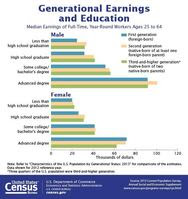
Native-born children of a foreign-born parent, also known as the second generation, were more likely to be college-educated and have higher incomes than their parents’ generation, according to a first-ever report from the U.S. Census Bureau. Additionally, this second-generation group surpasses education and income levels of the generations that follow them.
Characteristics of the U.S. Population by Generational Status: 2013 examines differences among the foreign-born or “first generation,” the second generation (native-born with at least one foreign-born parent) and the third-and-higher generation (native-born with two native-born parents) using data from the Current Population Survey. Three quarters of the U.S. population were third-and-higher generation, and the remaining quarter of the U.S. population was made up of approximately equal parts first and second generation.
“The expectation that one’s economic status will improve over one’s parents and grandparents is particularly salient in immigrant communities, in which the first generation often must work harder to overcome numerous cultural and economic challenges,” lead report author Edward Trevelyan said. “This report looks for evidence of such intergenerational mobility.”
Of the second generation, 37.4 percent had a bachelor’s degree or higher and 14.9 percent had a master’s degree or higher. In comparison, 31.4 percent of all subsequent generations had at least a bachelor’s degree and 11.1 percent had a master’s degree or higher. For the first generation, 30.1 percent had a bachelor’s degree or higher and 12.1 percent had a master’s degree or higher. Among all generation groups, full-time employment was highest for those with a bachelor’s degree or higher.
The second generation also had a higher median household income than the first generation at $51,291 compared to $45,475, respectively. For subsequent generations, median household income was $51,853, which is not statistically different from the second-generation’s income. Median incomes for second-generation individuals in all age groups were equal to or higher than median incomes for other generations.
In addition, the third-and-higher generation’s poverty rate of 13.6 percent was lower than the poverty rates of the first and second generations, both about 19.0 percent.
Other highlights:
Age
· The median age of the second generation (21 years) was considerably lower than that of the first and third-and-higher generations (43 years and 39 years, respectively).
· Median age has risen gradually over time for the first and third-and-higher generations, while remaining consistently low for the second generation.
· Nearly half of the second generation were under age 18, while over 80.0 percent of the first generation were ages 18 to 64.
Education
· The first generation had the lowest high school graduation rate at 72.1 percent.
· The first generation had the highest proportion of people who completed less than ninth grade at 17.3 percent, compared to 3.0 percent in the second generation and 2.2 percent of the third-and-higher generation.
· The first generation was less likely to attain some college or earn an associate’s degree (16.5 percent) than the second and third-and-higher generations (26.7 percent and 28.9 percent, respectively).
Labor Force/Income
· Labor force participation among the first generation (66.2 percent) was higher than the third-and-higher generation (63.0 percent) and the second generation(58.6 percent).
· First-generation workers ages 16 to 24, as well as age 65 and older, were more likely to work full time than second- and third-and-higher-generation workers in the same age group.
· The income gap between the sexes was smallest among the first generation, in which the median income of men ($39,082) was about 15.6 percent higher than women ($33,814), and largest among the third-and-higher generation, in which the median income of men ($52,072) was 28.0 percent higher than that of women ($40,531).
Poverty
· Among all family types, families with first-generation householders had higher poverty rates than families with second- or third-and-higher-generation householders.
· First-generation married couples had more than twice the poverty rate (13.9 percent) of second-generation married couples (5.8 percent), and nearly three times the rate of third-and-higher-generation married couples (4.7 percent).
Occupation
· First-generation workers were more likely than second- and third-and-higher-generation workers to be employed in service occupations.
Homeownership
· First-generation householders were less likely to live in homes that they owned, regardless of family type.
· Married-couple family householders were most likely to live in homes that they owned, regardless of generational status.
|
No comments:
Post a Comment